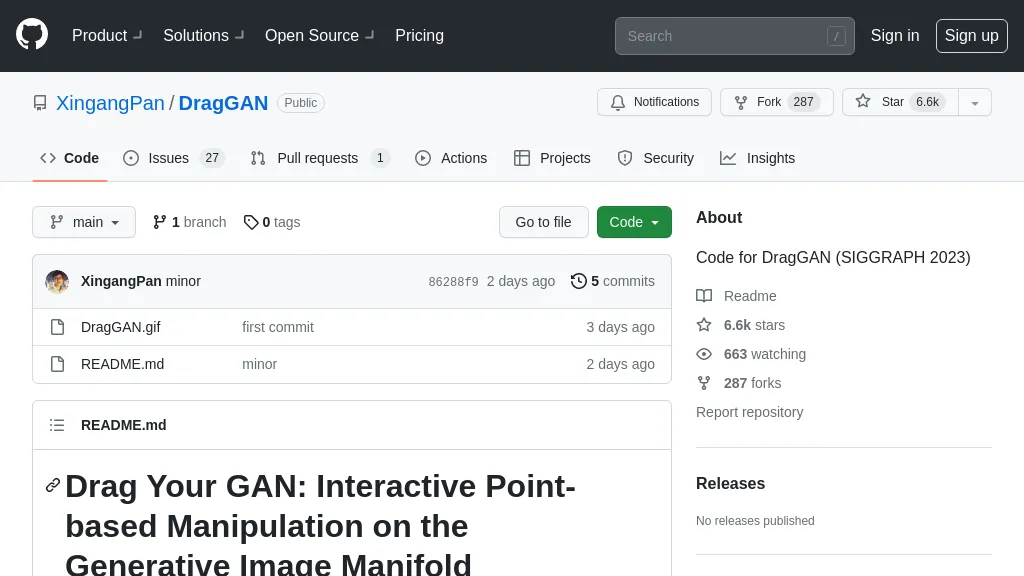What is DragGAN?
The name comes from a novel, intuitive interface for interactive point-based manipulations of generative image manifolds. New state-of-the-art in design work and image editing applications opens the possibility to manipulate and edit images in an easier and more detailed way. It made the user experience smooth and interactive, amplifying the power of GANs in making this tool a game changer in the field of digital design.
Key Features & Benefits of DragGAN
DragGAN is a complete package of features that make it an essential tool not only for artists but also for professional designers. Some salient features of the tool are as follows:
-
Point-based manipulation:
The user can edit an image at any specific point; this gives users ultimate control in editing. -
Active design:
The platform offers interaction with the user in real time through active editing to enhance the engagement of the user. -
Generative image editing:
DragGAN implements higher functionalities of image editing using GANs. -
Full-image manipulation tool:
It is designed for manipulating images according to one’s needs.
This changes the game because the novelty itself places it apart from other similar classes, making it a professional’s tool. Some of the benefits that come along with using DragGAN include efficiency, more creative control, and the capability to produce professional-quality images with much ease. Its selling points are unique in that the ease of use of the interface and the advanced editing capability that it brings combine to offer an experience unlike any other for all users.
Applications and Use Cases of DragGAN
DragGAN has a whole lot of applications. Some of them are as follows:
-
Design work:
Very helpful for the designer in making detailed and proper designs. -
Image manipulation:
Useful if someone wants to manipulate images for artistic or professional reasons. -
Editing software:
Can be used in conjunction with other editing applications to enhance the overall workflow and productivity.
Advertisements, media, entertainment, and nearly all those industries where the principal activity involves visual content, are the fields where DragGAN could be used. Target users who derive most benefits from this tool are artists, designers, and photographers.
How to Use DragGAN
DragGAN is very easy and efficient to use. Here’s how:
-
Upload your image:
Drag and drop, or upload the image that you want to edit. -
Select points:
You choose those on the image that you would want to manipulate and drag-drop from using this interactive interface in view of seeing, in real time, the desired effect on the image. -
Save and export your edited image:
Here are some additional tips and best practices: - Try different points to see how they affect the image.
- Use the zoom feature for more detailed adjustments.
- Utilize the real-time feedback for precise editing.
How DragGAN Works
DragGAN runs off the generative adversarial networks, which involve a generator and a discriminator working together in the generation of quality images. The tool helps the user to interact with the generative image manifold directly by selecting specific points in the image and manipulating them.
The underlying technology leverages advanced algorithms and models for its functionality, making real-time interactive editing possible. The workflow involves selecting points by the user that are then processed internally with the help of GANs and changing the image accordingly.
Pros and Cons of DragGAN
Like any other tool, it has its pros and cons:
Pros:
- Extremely intuitive and user-friendly interface.
- Provides exact control over manipulating images.
- Real-time feedback enhances the editing experience.
- Various applications across several fields.
Cons:
- Can be overwhelming for those who have never worked with GAN-based tools.
- It sometimes depends on the complexity of the image.
- Limited by point-based manipulation only; may not be fitting for all types of manipulation.
The general reaction among users has been very positive, where most appreciated the ingenuity behind this tool and the simplicity of it. Yet a few felt the challenge presented at first as a minor hindrance.
Price of DragGAN
While detailed pricing plans of DragGAN are not specified, the value for money that it offers would have to be weighed against competitors. Unique features, advanced capabilities, and a strong case for its adoption surely lie in store, especially for professionals seeking high-quality image editing solutions.
Conclusion about DragGAN
Sincerely speaking, DragGAN changed the game of how picture manipulation and editing had been performed. The feature of point-based manipulation, interactive design, and generative image editing identifies it from a special position for artists, designers, and photographers. While it has some minor disadvantages, its overall benefits outweigh them; hence, it forms a great addition to any professional toolset.
In the future, further development and updates promise to make it even more functional; thus, it will be an even more powerful tool for creative professionals.
DragGAN FAQs
Q: What is DragGAN?
A: DragGAN is an interactive manipulation tool on a point-based generative image manifold, powered with advanced image editing by GANs.
Q: Who will be able to use DragGAN?
A: DragGAN would be very useful for artists, designers, photographers, and professionals in the industries of advertising, media, and entertainment.
Q: How do I use DragGAN?
A: Load your image, select points to manipulate, drag and adjust those points in real time, and then save and export your edited image.
Q: What are the main features of DragGAN?
A: It includes point-based manipulation, interactive design, generative image editing, and full-image manipulation capabilities.
Q: What are the disadvantages of DragGAN?
A: The disadvantages are a steep learning curve for new users, and performance may vary with different image complexities.










